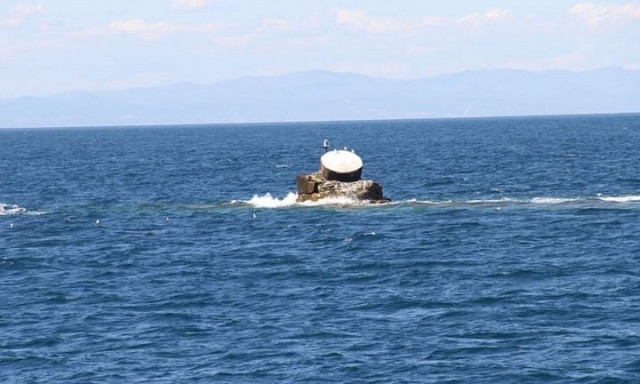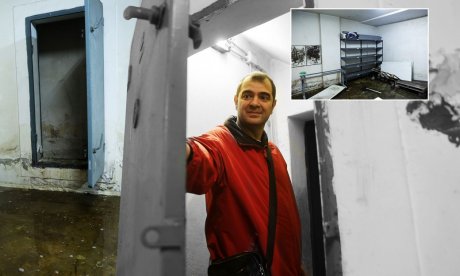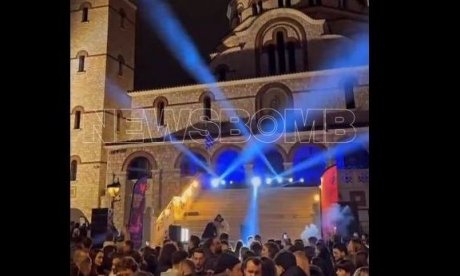Amphipolis: Puzzles" the possibility of the tomb to be looted
All scenarios circulating on the internet by experts and non-experts - How the ancients had "locked" the tomb from the appetites of grave robbers

From the so far course of the excavation of the tomb of Amphipolis many expressed the view that the tomb may has been looted.
This is because the heads of the sphinxes have not been found and secondly because of the existence of an opening 40 x 50 cm in the intermediate wall, found after the removal of soil covering the entrance beneath the Sphinx.
Regarding the first part, the Sphinxes are deliberately headless for symbolic reasons or for other reasons related to the safety of the monument. The fact that they did not find the heads of the Sphinxes reinforces this view as it is unlikely to have been stolen by robbers since they care only for valuables and it is reasonable to ignore such bulky and very heavy objects.
As for the second, according to the empedotimos.blogspot.gr, the existence of the opening is deliberate and provided by the manufacturer, (in this case Deinokratis), for reasons relating to the safety of the monument.
As you can see in the pictures, the entrance of the tomb is at some distance inside the impressive courtyard of 497 meters. Since from there begins the descent through the 13 stair steps that have already been found, it seems that finally the entrance with the Sphinxes is located at the base level of the enclosure.
(It should be noted that the orientation of the entry is not on the radius of the enclosure, but has lateral direction, at an angle to the radius. Obviously this was done in order to disorientate the potential 'invaders', since most likely, someone who sees this circular mound to seek entry in a direction towards the center of the circle and thereby excavating along the radial direction. In this case are increasing the chances to overtake the entrance of the monument or to find the side walls of the entry).
So, it is formed a zone of 2 meters width within the precinct, which is covering the grave and is the first mound for potential grave robbers.
So, if anyone was trying to enter the tomb of the level of the enclosure, first should have to destroy the impressive courtyard of Thassos marble, should then be dug into the soil for 2-3 meters to definitely reach the second wall, which in front of the entrance of the Sphinxes appears as a protective wall with boulders and runs around the entire monument.
From any point above the enclosure, the potential robbers would not discover anything, as by digging horizontally they would just might skip over the grave, since the grave seems to be below the level of the enclosure.
They could find only the Sphinxes, but first they had to destroy the protective wall at this point, as unfortunately happened.

But the picture that would see would be as shown in the photo below:

They would encounter a wall of soil behind the Sphinxes which certainly would discourage any other effort. Thus as shown in the photograph, the wall is obvious that it is made by human hands, as the soil is compressed and compact. So there was plenty of dirt from the banks of the Strymon which used by manufacturers to insure the monument.
The idea that the area may be covered by the debris of the Strymon River during flooding is not correct, because in this case the wall would not be on this perfect compression, nor the Sphinxes would remain so clean and free of dirt. The space that the two Sphinxes are located is amazingly clean and tidy (unless it is a work of archaeologists, so the aspiring robbers would be even more disappointed).
Nor is it possible that the entire embankment of vestibule happened from a possible collapse of the roof, because it was untouched.
So it seems that the whole space of the vestibule had covered thoroughly by soil. Indicative of this intention of the manufacturers is that there are no doors at the entrance, as the space would be sealed by a protective wall.
So as we can see, the whole area from the entrance to the intermediate wall was full of dirt. Considering the dimensions (3 x 4.5 x 6) the aspiring robber would find a compact volume 81 cubic meters of soil, which would surely be almost impossible to penetrate.
According to the indications, after the intermediate wall there is another room filled with soil and maybe there is another room which might lead to the main tomb.
So, maybe the ground plan of the tomb, to look like this:
By the sealing of the tomb, after having sealed the door of the main tomb (T2) and followed by sealing the chamber T2 by sealing the door (T1), there should be an opening to fill the space H2 with soil, along the lines of the backfill chamber (H1), by workmen who would evidently be in chamber H1, and having done this, to complete the sealing of H1 with the construction of the protective wall and filling the whole H1 space.
This is therefore the purpose of the notorious opening 40 x 50 cm! That opening is there to facilitate the sealing of the monument.
If there was a detachment of the rock that covered the opening due, -either tomb looting or because detachment due to geological phenomenon-, the rock should be found at the back of the intermediate wall, in the space H2 (because it seems that was not found in the chamber H1).
[Even if we take the extreme case that there was looting, then:
If the alleged desecration occurred before the space fills with dirt from the debris, then the robbers would have made opening in the base of the intermediate wall and not at the upper end of the summit, which is over 3 meters tall and up to which would be impossible to climb.
If the space was filled with flood debris, then it is inherently impossible for the robbers to had reached up to that point because the area would have been covered with soil.]
If the above reasoning is correct we conclude that it is inherently impossible for the tomb to has been looted, at least at the level of the enclosure, as well as any point at a height above the height of a horizontal enclosure, since the aspiring robbers would find nothing.
In other words, both horizontally and vertically, the tomb is fully insured.
Source: empedotimos.blogspot.gr
























